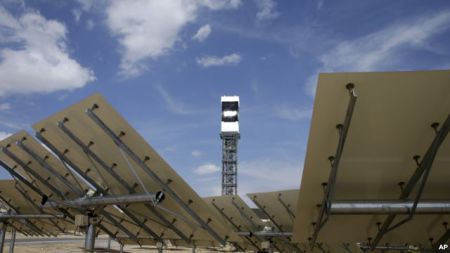Solar’s Future Looks Brighter

A concentrating solar power plant in Primm, Nev., is seen in this file photo. The site uses over 300,000 mirrors to focus sunlight on boilers’ tubes atop 450 foot power towers heating water into steam which in turn drives turbines to create electricity.
Pin It
RELATED ARTICLES
EU Leaders Seek Climate Deal, Clash Over Costs
At Brussels summit, EU policymakers aim to strike balance between big business, more innovative companies and green campaigners
Solar Power Plant in Africa to Supply Europe
Just 0.3 percent of the Saharan Desert’s intense solar energy could provide Europe with all the electrical power it needs
VOA News
October 30, 2014 3:01 PM
Scientists have created a new solar power material they call the “black hole of light” because it can absorb and convert to heat 90 percent of the sunlight it captures.
A team of researchers at the University of California at San Diego developed the silicon boride-coated nanoshell material that can be used in concentrating solar power (CSP) plants, according to a news release.
Researchers said the new material could increase the efficiency of CSPs by about 30 percent.
CSP plants consist of thousands of mirrors, which reflect sunlight at a central tower covered in a light absorbing material. The concentrated light is converted to heat which can power a steam turbine that produces electricity.
CSP power plants work by heating molten salt, which can be stored in thermal storage tanks and continue to produce energy even when it’s dark. This is a big advantage over photovoltaic cells, which stop producing energy at night.
Researchers said one big advantage of their material is its durability: It withstands heat of over 700 degrees Celsius and can survive exposure to other elements. They added that the plants are more efficient at higher temperatures.
Currently, CSP plants have to reapply sunlight absorption material about once a year, meaning the plant is not producing energy during the maintenance.
The UC San Diego team says their material has a longer lifespan, adding they are “close to achieving” a material that will last for “many years.”
CSP plants currently produce about 3.5 gigawatts of energy globally, which is enough to provide electrical power to more than 2 million homes. That number could rise to 20 gigawatts in coming years.
There was also good news about solar power in a report released by Deutsche Bank this week, which said rooftop photovoltaic energy will be as cheap or cheaper than other sources of electricity in 47 U.S. states by as early as 2016.
The report, written by Deutsche Bank’s leading solar energy analyst Vishal Shah, assumes the U.S. will continue a 30 percent tax credit on solar system costs. The credit it due to expire in 2016 as well.
According to the report, even if the tax credit were to be cut by two thirds, solar power would still achieve parity with other forms of electricity in 36 states.
Currently solar power costs the same as other sources of electricity in only 10 states.
The report says the amount of electricity from solar panels in the U.S. could be 16 times greater in 2016 than it was in 2008.
These trends in solar come at a time of dropping fossil fuel prices, which usually triggers a loss of interest in solar.
Earlier this year the International Energy Agency said concentrating solar power plants could provide 11 percent of the world’s electricity by 2050. Photovoltaic systems could account for another 16 percent, the agency said.
Currently, solar power accounts for less than one percent of the world’s electricity needs.
 KOHA JONË SONDAZH
KOHA JONË SONDAZH





















